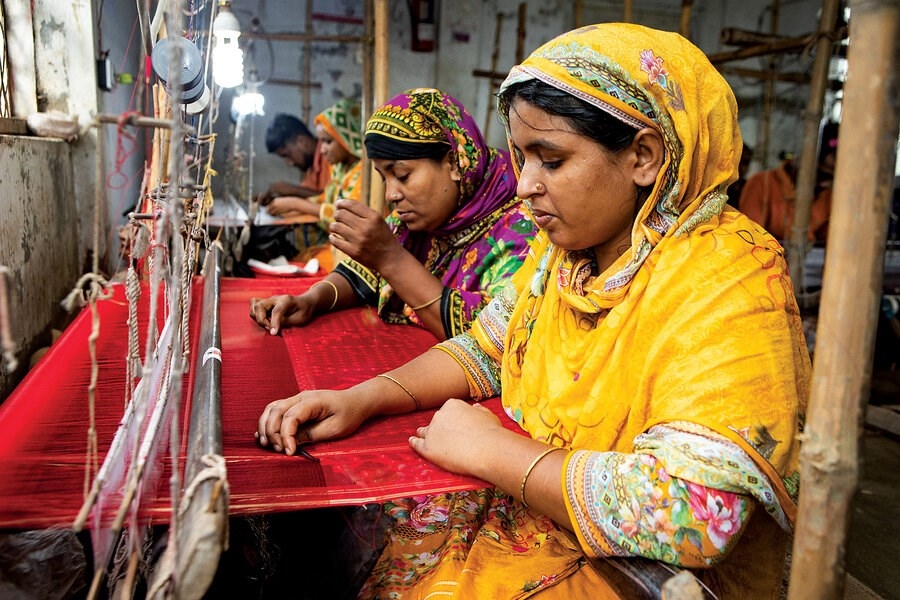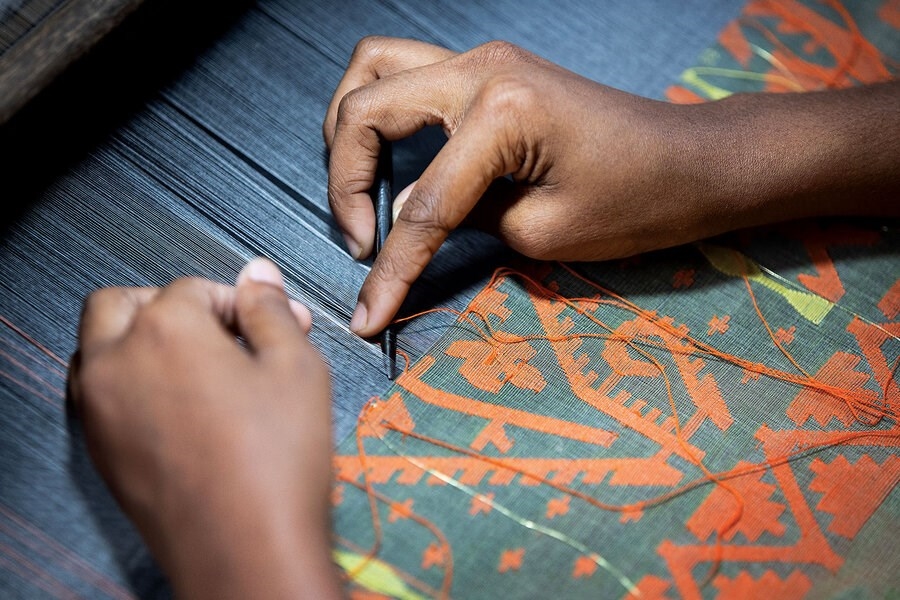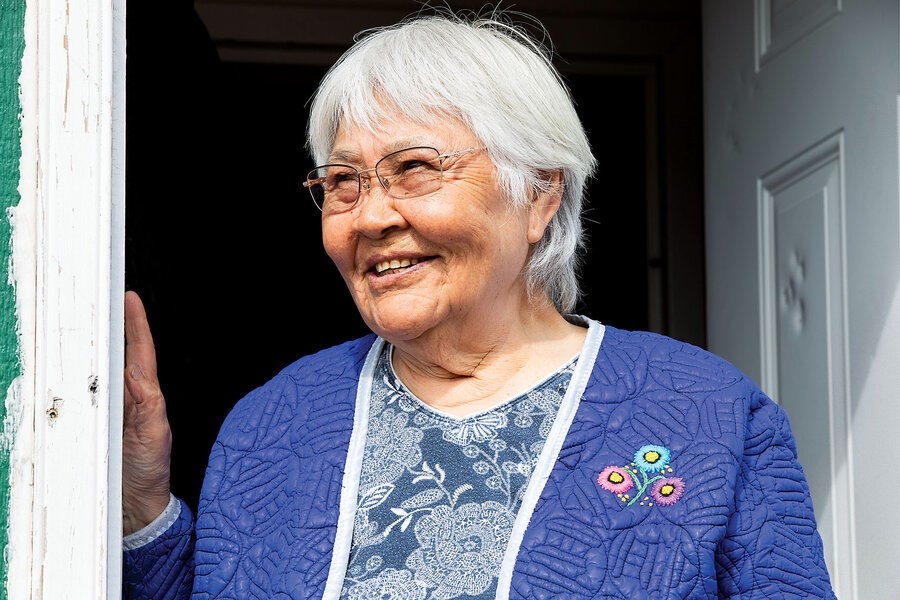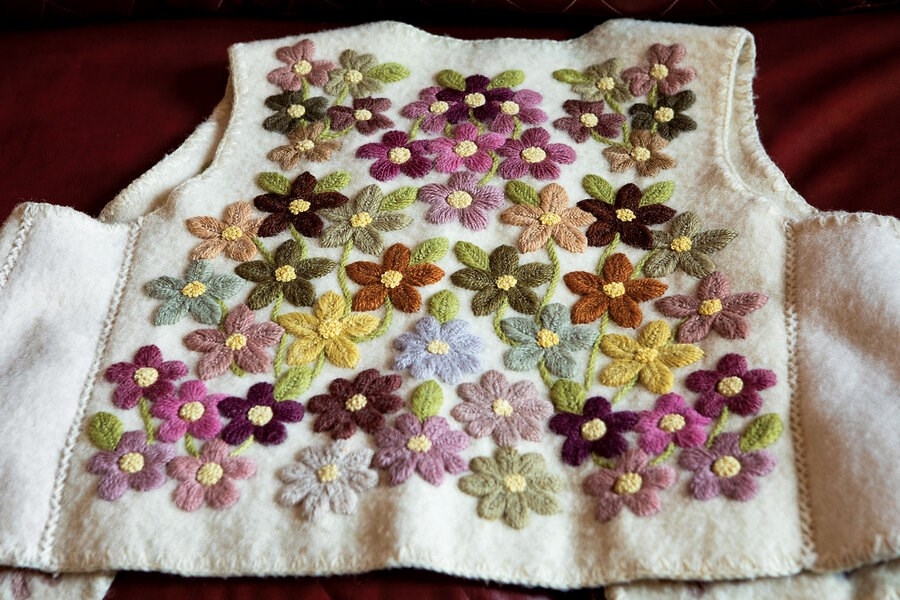REPRINTED WITH PERMISSION FROM THE CHRISTIAN SCIENCE MONITOR
Focus is often put on preserving disappearing languages, but what of other traditions? For some, vitality rests with maintaining a culture’s visual representations, too.
 Artisans work on jamdanis at Abul Kalam Jamdani Weaving Factory, Sept. 24, 2023, in Bangladesh. Each garment can take up to six months to complete.Melanie Stetson Freeman/Staff
Artisans work on jamdanis at Abul Kalam Jamdani Weaving Factory, Sept. 24, 2023, in Bangladesh. Each garment can take up to six months to complete.Melanie Stetson Freeman/Staff
| RUPGANJ, BANGLADESH; AND TALOYOAK, NUNAVUT - Two dozen artisans crouch over hand looms threaded with bright-orange and sky-blue cottons. Their fingers nimbly create a jamdani, an intricately woven sari dating back to the Mughal Empire.
Decades ago, this workshop on the Shitalakshya River, east of the Bangladeshi capital, Dhaka, would have been silent. Made of fine cotton or silk, the jamdani was a pinnacle of fashion centuries ago. But in the 19th century, British colonizers brought in their iteration of fast fashion, and the tradition nearly went extinct until its revival some five decades ago.
After Bangladesh became an independent nation in 1971, the nongovernmental organization Building Resources Across Communities (BRAC) set out to revitalize the weaving practice. It approached artisan families like that of Anwar Islam, owner of this shop. “I didn’t think it was feasible, but I was happy to be part of the solution,” says Mr. Islam.
Today he employs 120 weavers at Abul Kalam Jamdani Weaving Factory. Their jamdanis have been worn by everyone from Bangladeshi Prime Minister Sheikh Hasina Wazed to Bangladeshi actor Azmeri Haque Badhon at the 2021 Cannes Film Festival.
But this is not just a business success story. In an age in which “locally made” is a moral demand of many consumers, when the pushback against cultural appropriation and the industrialization of fashion and art gains force, the jamdani is seen as a story of cultural success, too. It’s part of the championing and preservation of objects from sealskin parkas in the Arctic to duck decoys and quilts across the United States that otherwise may be forgotten.
 Melanie Stetson Freeman/StaffIn Bangladesh, a weaver uses thread made of silk and cotton to craft a jamdani sari.
Melanie Stetson Freeman/StaffIn Bangladesh, a weaver uses thread made of silk and cotton to craft a jamdani sari.
“People have been striving to decorate their lives to tell the world who they are for centuries,” says Chris Gorman, a deputy director of the American Folk Art Museum in New York, which put on “American Weathervanes: The Art of the Winds” in 2021.
“These objects are made to be functional, but they are also forms of art,” he says. “And, I think, without people championing the study and preservation of objects like these, and others, there is the possibility that people will simply forget about them, and it is hard to revive them or prove their relevance.”
About the time the jamdani was being revived, a women’s collective was coming to life at the northernmost tip of Canada, in the town of Taloyoak.
Begun in 1972, the group, called Arnaqarvik, garnered a burst of fame in its day with its Inuit parkas, mitts, and boots made from caribou, wolf, and seal and patterned with dyes from tundra lichen and flowers. The collective’s work – including, eventually, duffel-wool “packing dolls,” or miniature stuffed animals carrying their babies in parkas as the Inuit do – was showcased in New York City and the 1974 Arctic Winter Games in Alaska.
Yet today, just as the jamdani is enjoying global appeal, the work of Arnaqarvik has been largely forgotten. So the Kitikmeot Heritage Society in Cambridge Bay, in Canada’s Nunavut territory, has set out to restore its memory in a digital archive.
And to mark the 50th anniversary of the collective, about 250 items in 2021 were sent back to Taloyoak in an exhibition. It was the first time most in the community found out what Arnaqarvik even was. “Everybody was really surprised by what their parents did in those days,” says Arnaoyok Alookee, Arnaqarvik’s co-founder.
 Melanie Stetson Freeman/StaffArnaoyok Alookee helped found a sewing cooperative in Canada in the 1970s. Today, she shares her skills with young people.
Melanie Stetson Freeman/StaffArnaoyok Alookee helped found a sewing cooperative in Canada in the 1970s. Today, she shares her skills with young people.
Brendan Griebel, an Arctic anthropologist and manager of collections and archives for the Kitikmeot Heritage Society, says this reconnection is about far more than just the production of goods. “Having that physical contact ignites something in the memory and in the senses,” he says.
When Arnaqarvik began, the semi-nomadic Inuit of Taloyoak had only gradually moved into this permanent settlement the decade prior. The collective helped the community bridge a gap – between its Indigenous traditions and the new wage economy into which it was settling.
Judy McGrath co-founded the collective with Ms. Alookee when her husband was posted for work in the Arctic community. She says she still recalls the sense of purpose that craft-making gave all of them. They collected flowers with their children in 24-hour sunlight; they’d use the 24-hour darkness of winter to boil their dyes on the stove. “I can still feel the confidence that the skills they had mattered, and the excitement over making new things from the old, from the land,” Ms. McGrath says.
In Bangladesh, the rise of the jamdani was also driven by economics, to help artisans whose enormous skills couldn’t find the market for livelihoods. BRAC, the country’s largest NGO, created the brand Aarong to distribute their products – from finely woven garments to woodcarved wares.
Today the brand supports 65,000 artisans across the country – mostly women – whose work is featured in stores including Aarong’s massive, high-end flagship in Dhaka.
Aarong has helped surface a narrative about a “good job” in a country known for its links with fast fashion. Stories of child labor and tragedy in the garment industry include the Rana Plaza collapse in Dhaka in 2013 when over 1,000 people were killed.
 Melanie Stetson Freeman/StaffA vest, made in the 1970s by Arnaoyok Alookee in Canada, has embroidered flowers with wool dyed with local plants such as lichen.
Melanie Stetson Freeman/StaffA vest, made in the 1970s by Arnaoyok Alookee in Canada, has embroidered flowers with wool dyed with local plants such as lichen.
Making a jamdani, which derives from the Persian words jam (floral) and dani (vase), is what weaver Mohammed Monir calls a “respectful” job, he says while working on a recent day. “When I see someone famous wearing something I made, I feel proud,” he adds.
Each floral pattern runs the length of the scarf requiring an entire day of work in pairs. The finest jamdanis can take up to six months to complete. Today jamdani weaving is included on UNESCO’s Representative List of the Intangible Cultural Heritage of Humanity.
But to rebuild the culture in Bangladesh required research into archives. That included visiting museums worldwide where jamdanis were preserved and bringing back photos and documentation to reteach the art form.
It is, in some ways, where Taloyoak, back in Canada, finds itself now.
The collective had disbanded by the 1980s, but Mona Igutsaq now runs Taluq Design out of a single-room storefront that has taught sewing to women here since 1995. In an interview in June, Ms. Igutsaq said she wanted to soon offer a course on how to make packing dolls.
“It’s very important to carry on the tradition. It’s unique. No one else in the world does them,” she says.
And even if the collective itself no longer exists, Ms. Alookee says she does what she can to pass down her sewing skills – to her granddaughters and at the local school. “A lot of young people, they think they don’t know how to do things,” she says. But all they need is a good teacher and patience to learn. “It lifts them up and makes them stronger, and then they want to do more.”
And that’s how cultural heritage is preserved. “People talk about, with these objects, how this knowledge is sleeping,” says Mr. Griebel, “and you really need to wake it up.”
Page created on 3/10/2024 10:24:27 PM
Last edited 3/10/2024 10:38:58 PM
